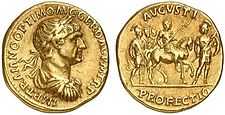Profectio
| Traianus: aureus[1] |
 |
| IMP TRAIANO OPTIMO AVG GER DAC P M TR P, Laureate, draped and cuirassed bust of Trajan to right. |
PROFECTIO AUGUSTI, Traianus, in military dress and hold spear, on horse walking to right; before him, soldier walking right, head turned back to left; behind, three soldiers walking right. |
| 7,35 g, coined in 114/115. |
|
|
|
|
|
| Alexander Severus: sestertius[4] |
 |
| IMP SEV ALEXANDER AVG, laureate head to right, draped bust; |
PROFECTIO AVGVSTI, Alexander Severus on horse, holding transverse spear, preceded by Victoria, with a crown and palm. |
| coined in 231/232. |
|
The profectio ("setting forth") was the ceremonial departure of a consul in his guise as a general in Republican Rome,[5] and of an emperor during the Imperial era.[6] It was a conventional scene for relief sculpture and imperial coinage.[7] The return was the reditus[8] and the ceremonial reentry the adventus.[9]
References
- ↑ Roman Imperial Coinage, Traianus, II, 297; BMC 512 var. Calicó 986a. Cohen 40 var. Hill 690.
- ↑ Roman Imperial Coinage, Marcus Aurelius, III 977; MIR 18, 191-6/30; Cohen 502.
- ↑ Roman Imperial Coinage, Septimius Severus, IVa, 494; BMC 466. Cohen 580.
- ↑ Roman Imperial Coinage, Alexander Severus, IVb, 596; Cohen, 492.
- ↑ Andrew Feldherr, Spectacle and Society in Livy's History (University of California Press, 1998), pp. 9–10.
- ↑ Erika Manders, Coining Images of Power: Patterns in the Representation of Roman Emperors on Imperial Coinage, A.D. 193–282 (Brill, 2012), p. 71.
- ↑ Manders, Coining Images of Power, p. 70–76.
- ↑ Geoffrey S. Sumi, Ceremony and Power: Performing Politics in Rome Between Republic and Empire (University of Michigan Press, 2005), p. 35.
- ↑ Manders, Coining Images of Power, p. 70.
External links



